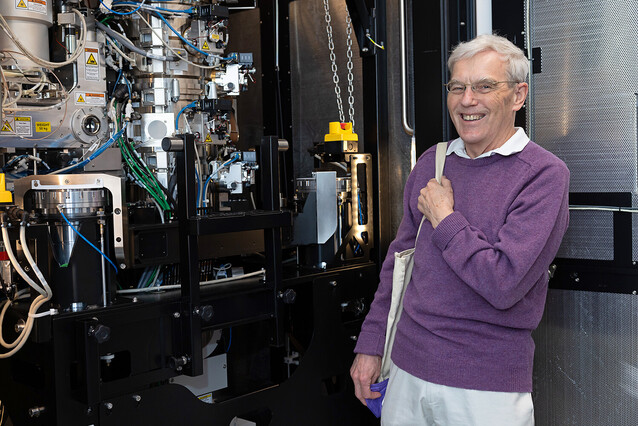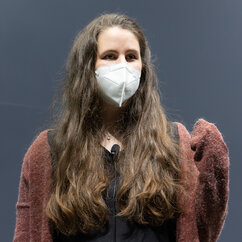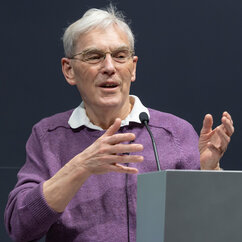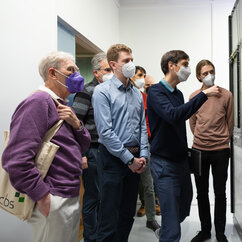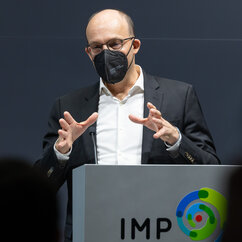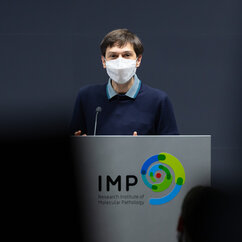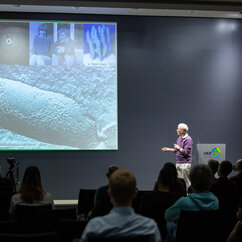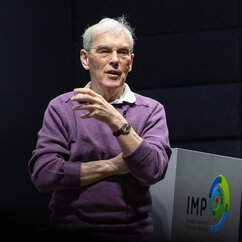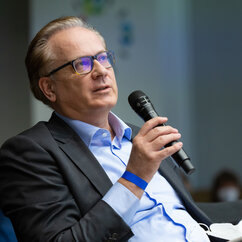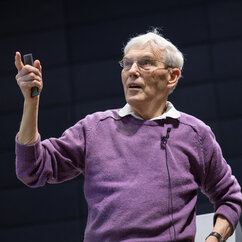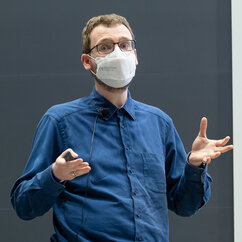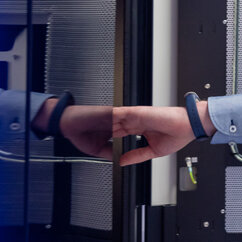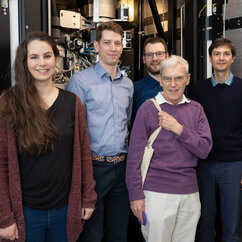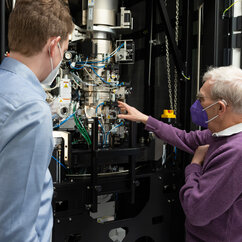Krios G4: IMP enters next level of cryo-Electron Microscopy
With a keynote lecture by cryo-electron microscopy pioneer and Nobel laureate Richard Henderson, the IMP marked the installation of a Krios G4 electron microscope. The device was generously funded by Boehringer Ingelheim and will propel structural biology to the next level.
Today, the IMP and Boehringer Ingelheim jointly held a symposium to mark the installation of a Krios G4 cryo-electron microscope. The device is the most advanced of its kind in Austria and was generously funded by the IMP’s main sponsor Boehringer Ingelheim. IMP scientists and Boehringer researchers will each share the use of the Krios G4 equally.
“The Krios allows us to dissect the molecular architecture of the machines in our cells and to take a high-resolution look at their arrangement within cells”, said IMP group leader David Haselbach in outlining the opportunities that now opened up. “High-end cryo-EM provides the missing link to connect the world of cells and tissues to the world of atoms and chemical bonds. With this, we will be able to study pathologies from their molecular origin and follow them to their physiological consequences.” The structural work done with cryo-EM often links different research groups at the IMP in collaborative projects – this was the case already in the past, and the scientists expect that the Krios will catalyse more of these collaborations.
Symposium gallery
Setting the course for structural biology at the IMP
Conventional electron microscopes tend to damage the samples that scientists wish to visualise, which results in an altered image of the cellular structures under examination. In contrast, cryo-electron microscopes such as the Krios G4 minimise damages through the process of vitrification: the sample gets turned into a glass-like state by means of ultra-rapid freezing. The specimen is then scanned in the microscope, which is also cooled to very low temperatures, by an electron beam accelerated to 80 percent of the speed of light.
Through cryo-EM, structural biologists obtain three-dimensional images of high accuracy, either by analysing a high number of identical molecules and averaging the results; or by taking images of cellular specimens in many different planes – the tomographic method.
The Krios G4 has a very fast and sensitive camera and improved optics with lower aberration errors than previous cryo-electron microscopes. The extremely high voltage of 300 kilovolts produces a high-energy electron beam that is in contact with the sample for an even shorter period of time, and thus causes less radiation damage than older models.
In their welcome addresses, IMP directors Jan-Michael Peters and Harald Isemann expressed their gratitude to Boehringer Ingelheim for opening this new chapter in structural biology at the IMP. “Cryo-EMs are for molecular biology what space telescopes are for astronomy”, said Jan-Michael Peters to highlight the significance of the investment.
Nobel laureate outlines future of cryo-EM
A Birnstiel Lecture by the cryo-EM pioneer and Nobel Laureate Richard Henderson (MRC Laboratory of Molecular Biology) added an outstanding keynote to the occasion. Almost exactly two years ago, Richard Henderson’s Birnstiel Lecture was the first to be cancelled due to the pandemic. Ironically, it was now also the first one to be held after in-person lectures have become possible again. In his inspiring talk, Henderson outlined the rate at which cryo-EM is catching up with X-ray crystallography and predicted that it will soon become the primary source of structural information for molecular biologists.
In closing the event, participants of the symposium visited the new device, which is housed in a specially shielded facility. High-end electron microscopes such as the Krios G4 are very susceptible to vibrations and magnetic fields. Large masses, such as a tram passing nearby Schlachthausgasse, can change the Earth's magnetic field slightly. Although this change is in the nanotesla range and barely detectable, the distortion is detrimental for measurements below the nanometre range.
Therefore, the floor, walls, and ceiling of the Krios facility were lined with a foil made of μ-metal, a nickel-iron alloy able to completely shield magnetic interference fields. Since late January, the Krios G4 is being used day and night, with only short interruptions for defreezing once every two weeks.
